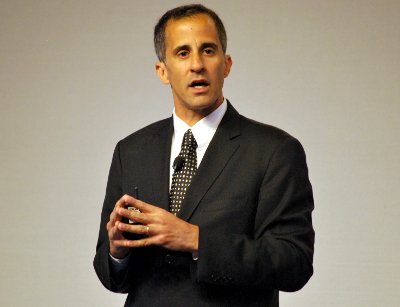Customers running HP’s CloudSystem-based on-premise cloud environments can now “cloud-burst” onto Amazon’s Elastic Compute Cloud, HP’s own public cloud (currently in beta) and enterprise-cloud infrastructure at Latisys data centers.
CloudSystem is HP’s integrated solution for building and managing cloud services. There are two flavors of CloudSystem: one for enterprises and one for service providers that want to offer cloud-based services.
Until the announcement, made Tuesday, HP had publicly named only one provider who could absorb capacity overspill from its customers' in-house clouds: Savvis. A source at HP tells us, however, that there are more such partners globally whose names HP has not disclosed.
More cloud-bursting options give clients more flexibility in deploying hybrid-cloud environments, mixing and matching a variety of cloud-infrastructure types.
Steve Dietch, VP of worldwide cloud at HP’s Enterprise Group, said hybrid cloud was the future, as traditional methods of deploying IT would not go away any time soon. “Traditional IT will be extremely important to customers in the world today,” he said during a press conference at HP’s Discover event in Las Vegas Tuesday.
While integration with EC2 gives CloudSystem customers the option to burst into a public cloud, the partnership with Latisys gives them an additional choice (besides Savvis) to burst into an enterprise-grade cloud infrastructure, Jonathan Sharp, VP of marketing at Latisys, said.
Latisys is a Denver-based data center provider with a host of colocation, managed, hosting and cloud services.
The company is a major HP customer, Sharp said, having built the majority of its cloud infrastructure on HP products. Latisys’ cloud consists of HP servers, 3Par storage systems and CloudSystem Matrix, an Infrastructure-as-a-Service solution for private and hybrid cloud deployments.
While optimized for HP servers, storage and networking gear, CloudSystem Matrix also supports other vendors’ x86 hardware. It supports Windows, Linux and HP-UX operating systems and VMware, Microsoft Hyper-V and Integrity VM hypervisors.
One of the key features CloudSystem Matrix gave Latisys, Sharp said, was the ability to give different cloud users different quality-of-service levels. This is important for the provider, as it tries to tailor services to individual customers’ needs.
“We treat the Cloud like any other IT-outsourcing engagement,” Sharp said.
Latisys’ cloud infrastructure is hosted in seven data centers around the US. The company owns all of them, having built many from scratch, Sharp said.
HP owns and operates a number of dedicated data centers hosting its cloud services. A company spokesman confirmed that two of them were in Las Vegas and North Carolina, declining to disclose any other locations.
The company's public cloud is built using an open architecture, taking to great extent parts of the open-source cloud architecture OpenStack.
Unlike Amazon, HP is going after enterprises with its public-cloud offering, Mohamed said, as it considers the enterprise-public-cloud space underserved. “We know there is a niche there that is open for anyone to take,” he said.
Corrected: a previous version of the artile said HP's public cloud was hosted in three data centers in Las Vegas, North Carolina and Zurich. According to an HP spokesman, that information was inaccurate. The article has been updated accordingly.

